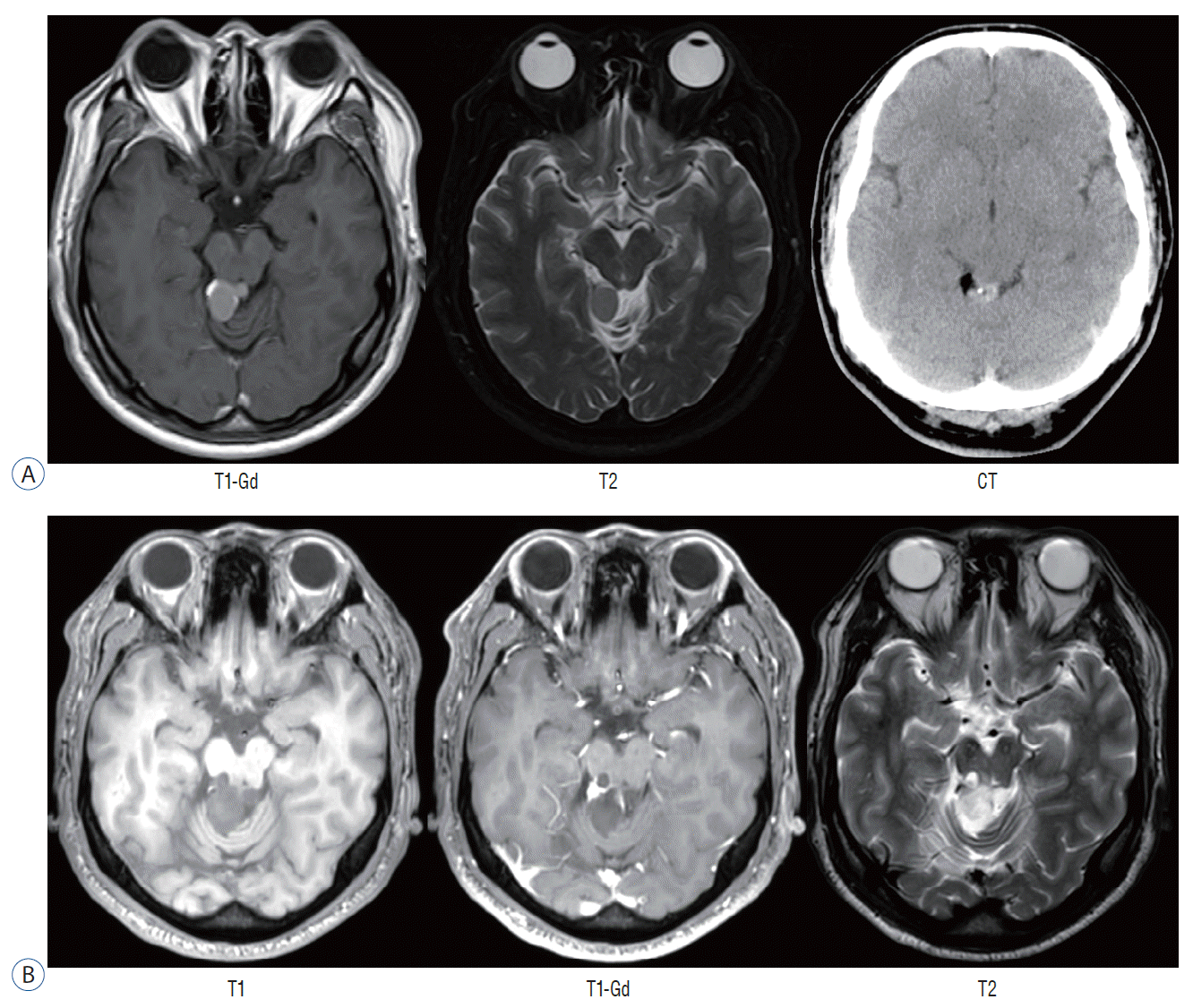1. Arseni C, Dănăilă L, Nicola N, Georgian M, Istrati C. Intracranial teratomas. Acta Neurochir (Wien). 20:37–51. 1969.

2. Barkley AS, Kuo CH, Leary SES, Ojemann JG, Susarla SM. Unusual radiographic presentation of intracranial mature teratoma and resection via supraorbital approach. World Neurosurg. 122:81–84. 2019.

3. Beschorner R, Schittenhelm J, Bueltmann E, Ritz R, Meyermann R, Mittelbronn M. Mature cerebellar teratoma in adulthood. Neuropathology. 29:176–180. 2009.

4. Bohara M, Yonezawa H, Karki P, Bakhtiar Y, Hirano H, Kitazono I, et al. Mature posterior fossa teratoma mimicking dermoid cyst. Brain Tumor Pathol. 30:262–265. 2013.

5. Buetow PC, Smirniotopoulos JG, Done S. Congenital brain tumors: a review of 45 cases. AJNR Am J Neuroradiol. 11:793–799. 1990.

6. Clack TD, McGillicuddy JE, Wolf GT. Labyrinthine functional tests and a case of midline cerebellar teratoma. Am J Otol. 9:481–488. 1988.
7. Coulibaly O, El Kacemi I, Fatemi N, Gana R, Saïdi A, Maaqili R, et al. Mature posterior fossa teratoma mimicking infratentorial meningioma: a case report. Neurochirurgie. 58:40–43. 2012.

8. Drapkin AJ, Rose WS, Pellmar MB. Mature teratoma in the fourth ventricle of an adult: case report and review of the literature. Neurosurgery. 21:404–410. 1987.

9. Goyal N, Kakkar A, Singh PK, Sharma MC, Chandra PS, Mahapatra AK, et al. Intracranial teratomas in children: a clinicopathological study. Childs Nerv Syst. 29:2035–2042. 2013.

10. Harada K, Okamoto H, Fujioka Y, Kiya K, Mukada K, Uozumi T, et al. Teratoma in the fourth ventricle of an elderly adult--case report. Neurol Med Chir (Tokyo). 24:499–503. 1984.
11. Jennings MT, Gelman R, Hochberg F. Intracranial germ-cell tumors: natural history and pathogenesis. J Neurosurg. 63:155–167. 1985.

12. Kyritsis AP. Management of primary intracranial germ cell tumors. J Neurooncol. 96:143–149. 2010.

13. Labauge R, Pagès M, Pagès A, Ségnarbieux F. Cerebellar teratoma in adults. Contribution of x-ray computed tomography and magnetic resonance imaging. Rev Neurol (Paris). 146:310–312. 1990.
14. Lee YH, Park EK, Park YS, Shim KW, Choi JU, Kim DS. Treatment and outcomes of primary intracranial teratoma. Childs Nerv Syst. 25:1581–1587. 2009.

15. Liu Z, Lv X, Wang W, An J, Duan F, Feng X, et al. Imaging characteristics of primary intracranial teratoma. Acta Radiol. 55:874–881. 2014.

16. Matsutani M, Sano K, Takakura K, Fujimaki T, Nakamura O, Funata N, et al. Primary intracranial germ cell tumors: a clinical analysis of 153 histologically verified cases. J Neurosurg. 86:446–455. 1997.

17. Noudel R, Vinchon M, Dhellemmes P, Litré CF, Rousseaux P. Intracranial teratomas in children: the role and timing of surgical removal. J Neurosurg Pediatr. 2:331–338. 2008.

18. Park KB, Park HS, Lee JI, Suh YL. Mature teratoma in the cerebellar hemisphere of an adult. J Korean Neurosurg Soc. 41:180–181. 2007.

19. Pöschl J, Berger F, Kretzschmar H, Schüller U. A 59-year-old man with two cerebellar lesions and disturbed cerebellar morphology. Brain Pathol. 25:790–791. 2015.

20. Sanyal P, Barui S, Mathur S, Basak U. A case of mature cystic teratoma arising from the fourth ventricle. Case Rep Pathol. 2013:702424. 2013.

21. Saura H, Beppu T, Matsuura H, Asahi S, Uesugi N, Sasaki M, et al. Intractable yawning associated with mature teratoma of the supramedial cerebellum. J Neurosurg. 121:387–389. 2014.

22. Strang RR. Teratomas of the posterior cranial fossa. Zentralbl Neurochir. 20:359–372. 1960.
23. Zavanone M, Alimehmeti R, Campanella R, Ram-Pini P, Locatelli M, Egidi M, et al. Cerebellar mature teratoma in adulthood. J Neurosurg Sci. 46:35–38. discussion 38. 2002.
24. Zhang S, Wang X, Liu X, Hui X. Mature teratoma in cerebellopontine angle in a 70-year-old female: a rare tumor with exceptional location, age, and presentation. Neurol India. 60:660–661. 2012.








 PDF
PDF Citation
Citation Print
Print





 XML Download
XML Download